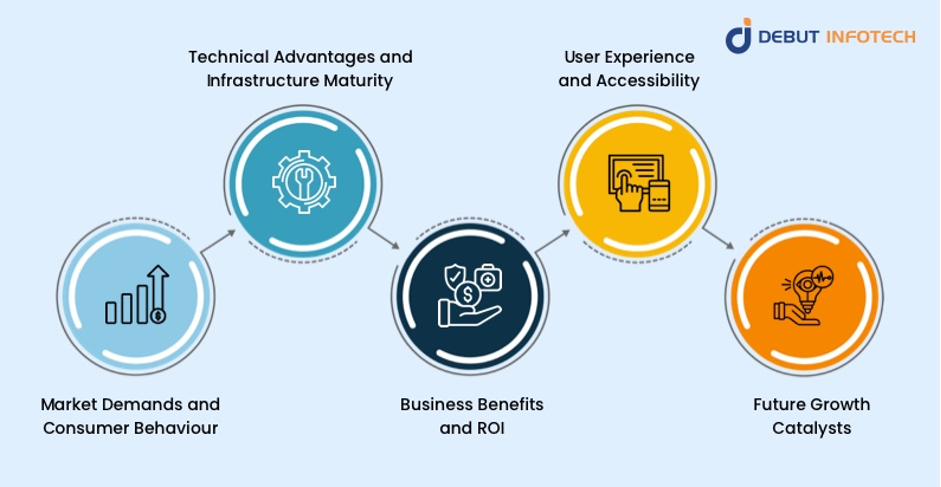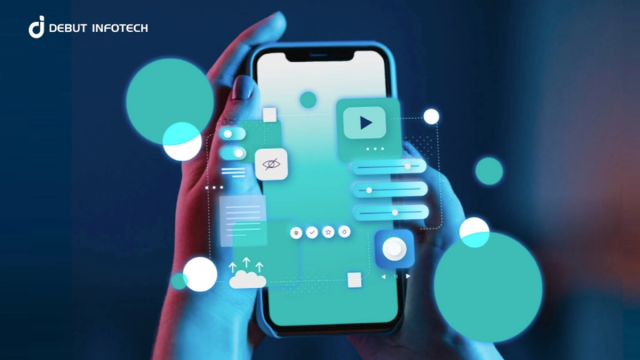For many years, mobile applications were robust software that took up huge storage spaces and processing power on mobile devices.
But recently, smartphone users have become pickier about their mobile downloads and storage spaces. Earlier versions of mobile applications required larger storage and computing power because single applications involved multiple components for performing different functions. However, these days, users just want applications that perform simple and specific functions.
Consequently, we’re seeing rapid acceleration in micro mobile app development across different industries. Micro mobile apps are rapidly replacing earlier versions of mobile apps.
Consider micro applications to be the digital equivalent of Swiss Army knives: small yet incredibly powerful. They are perfect for today’s hectic mobile interactions because they provide targeted functionality without the bloat of traditional applications. These simplified apps are demonstrating that less really is more, offering anything from expedited payment options to specialized business tools.
Are you curious about the reasons behind the industry leaders’ shift to micro apps? How might this change affect your development or company plan? This in-depth article explains why you can’t afford to lose out on this revolution and why these little powerhouses may be the next big thing in mobile technology.
What are Micro Mobile Apps?
Contents [show]
A micro application is a tiny, portable program designed for a single, easy operation. It is a specially designed HTML/HTML5 application that allows users to accomplish a few specialized tasks with minimal navigation. Because of its limited feature set, it loads more quickly, appears simpler, and completes the assigned tasks quickly.
Each app can be used independently or in conjunction with other micro apps to form more intricate software. A micro-app will do its designated function when called by the complex software.
Here are a few commonplace instances of micro apps
- Quick Pay at Restaurants: No app download is required to access the menu, place an order, and pay—just scan a QR code at your table.
- Transport Pass: To swiftly purchase and show a digital ticket, touch a link rather than using the entire transport app.
- Hotel Room Key: You can access your room without using the hotel’s entire app by using a simple web application that is texted to you.
Micro apps are especially appealing to companies that want to offer targeted, effective mobile experiences without the hassle of traditional app development. They prefer them to traditional mobile apps because they can be quickly deployed and updated without requiring users to download updates.
A Systematic Guide to Micro Mobile App Development
Since micro mobile apps function differently than traditional mobile apps, their development approach is also slightly different.
Micro mobile app development companies like Debut Infotech uses web technologies like HTML5, CSS3, and JavaScript in conjunction with contemporary frameworks like React Native or Flutter. This combination helps maintain near-native performance while drastically reducing development time and costs.
There are key development processes essential to the successful deployment of these Micro Mobile Apps. Let’s talk about them below:
1. Core Development Philosophy
The development process aims to produce lightweight, functional, and purpose-driven applications. As such, developers prioritize specific tangible features over full capabilities.
For instance, the Facebook Messenger app is a micro mobile app built solely for messaging. The full Facebook app, on the other hand, offers a wide range of features, including social networking, event management, news feeds, and many others.
In this instance, the focus of the Messenger app would be messaging, compared to the other features associated with the full Facebook app. Consequently, developing micro mobile apps results in faster development cycles and simpler maintenance processes.
2. Security and Optimisation
Despite the apps’ smaller footprint, developers prioritize security by adding strong authentication procedures and data encryption. To guarantee fast load times and seamless user experiences, they also concentrate on optimization techniques like code splitting, lazy loading, and effective caching tactics.
3. Technical Infrastructure
Modern tools like WebView containers, microservices architecture, and serverless functionalities are frequently included in the development stack. This makes it possible for upgrades and iterations to happen quickly without forcing consumers to download new versions. Furthermore, version control is made easier because web-based deployment allows updates to be sent to all users quickly.
4. Quality Assurance
With micro mobile applications, iteration testing and quality assurance become more efficient, concentrating on particular features rather than thorough system testing. In the end, this results in improved user experiences and more responsive product development by enabling quicker cycles for quality assurance and more frequent releases.
Related Read: How Much Does Mobile App Development Cost In 2025?
Understanding The Rise of Micro Mobile Apps: A Market Evolution

Market Demands and Consumer Behaviour
The rapid expansion of tiny mobile applications is a result of both digital weariness and shifting user preferences. Despite having dozens of apps installed, users might only routinely interact with them, demonstrating how picky today’s consumers are about their digital footprint.
Micro apps resolve this dilemma by providing immediate accessibility without requiring a commitment. Without the bloat of conventional apps, they satisfy the modern user’s need for rapid, effective interactions.
Technical Advantages and Infrastructure Maturity
Numerous developments in technology have produced the ideal conditions for micro applications to flourish. Some of these include the following:
- Faster data transmission, which is made possible by the widespread use of 5G networks
- Modern browsers now support advanced features that were previously only available in native apps
- Significant advancements in progressive web app (PWA) technology
- Reduced cloud infrastructure costs, despite increased capabilities
- The development of web-based development tools to accommodate sophisticated functionalities.
Business Benefits and ROI
Organizations are quickly adopting micro applications because of their strong economic benefits. Some of these business benefits include the following:
- Development expenses are usually cheaper than those of regular apps.
- Lesser time-to-market compared to traditional mobile apps because it involves the development of fewer features
- Updates can be released immediately without obtaining app store clearance
- User acquisition is easier without the hassle of downloads
- Analytics and user behavior tracking are more efficient
- Feature experimentation and A/B testing are made much simpler.
User Experience and Accessibility
Micro applications offer better user experiences, making them more popular with users. This improves user experience and accessibility is characterized by the following:
- Instant access without obstacles to installation
- Better performance on lower-end devices
- Quicker loading times than traditional apps
- Lower device storage needs
- Seamless upgrades without user input
- Increased platform accessibility
Future Growth Catalysts
The micro app ecosystem is expected to continue growing for a number of reasons, such as:
- Major tech platforms are expanding their support
- Developers are becoming more familiar with pertinent technologies
- Task-specific solutions are becoming more in demand
- Supporting technologies and frameworks are evolving
- Integration capabilities with current systems are improving.
This convergence of technological capability, market demand, and business benefits explains why micro mobile applications are experiencing unprecedented growth in today’s digital landscape. As the ecosystem continues to mature, we can expect to see even more innovative applications and use cases emerge.
Future of Mobile Apps: A Technological and Market Transformation
As we experience an increase in the development of micro mobile apps, some important trends and predictions are markers of future occurrences in micro mobile app development. Some of them include the following:
The Rise of Intelligent Micro Apps
As machine learning and artificial intelligence progress, micro applications have the potential to become increasingly sophisticated and context-aware.
By foreseeing consumer requirements before they are even spoken, they will employ predictive algorithms to provide highly customized experiences. Their capabilities will be further improved by the incorporation of edge computing, which will allow micro applications to handle data closer to the source, leading to reduced latency and nearly immediate answers.
Growth of the Market and Convergence of Technology
A number of significant technology convergences will drive this market’s growth. Some of them include the Internet of Things (IoT), which can extend engagement possibilities, and cloud technologies, which promote more complex backend infrastructures. In addition, 5G networks, which are now making internet connectivity faster and better, are poised to play crucial roles.
The revolutionary potential has already been shown by significant tech ecosystems, such as WeChat in China, where micro apps are already an essential part of everyday digital interactions.
Innovation and Sectoral Transformation
Micro app innovation is especially welcomed in emerging industries like healthcare, education, and finance.
Consider financial services that offer complicated transactions with one click, educational platforms that offer bite-sized learning modules, or medical micro apps that offer immediate diagnostic assistance. Thanks to these applications’ quick deployment, updating, and customization capabilities, businesses will be able to handle changing customer expectations with unparalleled agility.
Environmental Aspects and Sustainability
Furthermore, the sustainability component cannot be ignored. Compared to conventional mobile applications, micro apps use much less energy and computational power. These small programs provide an eco-friendly substitute for software programs that use a lot of resources, especially as discussions about digital carbon footprints gain momentum worldwide.
The Change in Mobile Technology Architecture
Micro apps may be more than a fad. As evidenced by the confluence of technology capabilities, market demands, and changing user expectations, they represent a fundamental redesign of mobile application architecture. They signify a significant change in the way we think about and engage with mobile technology, offering a more effective, user-centric, and flexible method of solving digital problems.
Conclusion: The Revolution of Micro Mobile Apps
After examining the revolutionary realm of micro mobile applications, we go back to the crucial query on the minds of all industry players:
Are these little, light apps really the way of the future for mobile technology?
The overwhelming weight of the evidence points to yes. A fundamental rethinking of mobile software development has resulted from what started as a quiet revolution in Silicon Valley.
They tackle the three main issues plaguing traditional mobile apps: the need for immediate, focused functionality, user selection, and storage limitations. Micro applications demonstrate that innovation is more about accuracy and efficiency than size.
Therefore, every business that doesn’t want to be left behind in the past must get on the moving train. That’s why top mobile software companies like Debut Infotech offer mobile app development solutions for the efficient development of micro mobile apps.
Micro mobile applications are more than simply a craze for developers, companies, and consumers. They are a purposeful development in response to our fast-paced, increasingly digital world.


